Methodological Approach for the Development of a Simplified Residential Building Energy Estimation in Temperate Climate
Abstract
1. Introduction
2. Materials and Methods
- Analysis of current energy building performance initiatives.
- Data collection: case study, user energy performance and present environmental conditions.
- Development and calibration of the energy model.
- Simulation scenarios: locations and U-value thresholds and proposals for walls and roofs.
- Energy consumption and linear regression.
- Equations for energy consumption estimation.
2.1. Analysis of Current Energy Performance of Buildings Initiatives
2.2. Data Collection
2.2.1. Case Study
2.2.2. User Energy Performance
2.2.3. Present Environmental Conditions
2.3. Development and Calibration of the Energy Model
2.4. Simulation Scenarios
2.4.1. Locations and U-value Thresholds
2.4.2. Proposals for Walls and Roofs
3. Results
3.1. Energy Consumption and Linear Regression
3.2. Equations for Energy Consumption Estimation
3.3. Contrasting Predictions from Equations and Established Methods
4. Discussion
5. Conclusions
Author Contributions
Funding
Acknowledgments
Conflicts of Interest
References
- Pérez-Lombard, L.; Ortiz, J.; RGonzález, R.; Maes, I.R. A review of benchmarking, rating and labelling concepts within the framework of building energy certification schemes. Energy Build. 2009, 41, 272–278. [Google Scholar] [CrossRef]
- Walsh, A.; Cóstola, D.; Labaki, C.L. Review of methods for climatic zoning for building energy efficiency programs. Build. Environ. 2017, 112, 337–350. [Google Scholar] [CrossRef]
- Baldwin, R.; Leach, S.J.; Doggart, J.; Attenboroug, M. BREEAM 1/90: An Environmental Assessment for New Office Designs; IHS BRE: Garston, UK, 1990. [Google Scholar]
- Feist, W. The Passive House in Darmstadt–Kranichstein during Spring, Summer, Autumn and Winter. 2006. Available online: https://passiv.de/former_conferences/Kran/Passive_House_Spring_Winter.htm (accessed on 17 November 2017).
- Cole, R.J.; Rousseau, D.; Theaker, I.T. Building Environmental Performance Assessment Criteria: Version 1 Office Buildings; UBC School of Architecture, Environmental Research Group: Vancouver, BC, Canada, 1993. [Google Scholar]
- U.S. Energy Information Administration. Energy Statistics; U.S. Energy Information Administration: Washington, DC, USA, 2017. Available online: https://www.eia.gov/beta/international/ (accessed on 5 May 2018).
- Peel, M.C.; Finlayson, B.L.; McMahon, T.A. Updated world map of the Koppen-Geiger climate classification. Hydrol. Earth Syst. Sci. 2007, 11, 1633–1644. [Google Scholar] [CrossRef]
- European Council. Directive 2002/91/EC of the European Parliament and of the Council of 16 December 2002 on the Energy Performance of Buildings; European Council: Brussels, Belgium, 2002. [Google Scholar]
- Mercader-Moyano, P.; Claro-Ponce, J. Sistemas de Certificación en Clima Templado. ARQUISUR Rev. 2017, 7, 62–77. [Google Scholar] [CrossRef]
- Netto, G.R. Sistemas de calificación edilicia en Latinoamérica. Master’s Thesis, Universidad Nacional de La Plata, La Plata, Argentina, 2017. [Google Scholar]
- Krsti, H.; Teni, M. Review of Methods for Buildings Energy Performance Modelling. IOP Conf. Ser. Mater. Sci. Eng. 2017, 245, 042049. [Google Scholar] [CrossRef]
- Crawley, D.B. Building Performance Simulation: A Tool for Policymaking. Ph.D. Thesis, The University of Strathclyde, Glasgow, UK, 2008. [Google Scholar]
- Melo, A.P.; Cóstola, D.; Lamberts, R.; Hensen, J.L.M. Assessing the accuracy of a simplified building energy simulation model using BESTEST: The case study of Brazilian regulation. Energy Build. 2012, 45, 219–228. [Google Scholar] [CrossRef]
- Petersdorff, C.; Boermans, T.; Harnisch, J. Mitigation of CO2 emissions from the EU-15 building stock: Beyond the EU Directive on the Energy Performance of Buildings. Environ. Sci. Pollut. Res. 2006, 13, 350–358. [Google Scholar] [CrossRef]
- Wong, S.L.; Wan, K.K.; Lam, T.N. Artificial neural networks for energy analysis of office buildings with daylighting. Appl. Energy 2010, 87, 551–557. [Google Scholar] [CrossRef]
- Korolija, I.; Zhang, Y.; Marjanovic-Halburd, L.; Hanby, V.I. Regression models for predicting UK office building energy consumption from heating and cooling demands. Energy Build. 2013, 59, 214–227. [Google Scholar] [CrossRef]
- Lopes, M.; Lamberts, R. Development of a metamodel to predict cooling energy consumption of HVAC systems in office different climates. Sustainability 2018, 10, 4718. [Google Scholar] [CrossRef]
- Mercader-Moyano, P.; Santiago, M.O.; Ramírez-de-Arellano, A. Modelo de cuantificación del consumo energético en edificación. Mater. de Construcción 2012, 62, 567–582. [Google Scholar] [CrossRef]
- Sánchez-García, D.; Rubio-Bellido, C.; Pulido-Arcas, J.; Guevara-García, F.; Canivell, J. Adaptive Comfort Models Applied to Existing Dwellings in Mediterranean Climate Considering Global Warming. Sustainability 2018, 10, 3507. [Google Scholar] [CrossRef]
- Ministerio de la Vivienda. Gobierno de España. Real Decreto 314/2006, de 17 de marzo, por el que se aprueba el Código Técnico de la Edificación; Ministerio de la Vivienda. Gobierno de España: Madrid, Spain, 2006. [Google Scholar]
- Escandón, R.; Suárez, R.; Sendra, J.J. On the assessment of the energy performance and environmental behaviour of social housing stock for the adjustment between simulated and measured data: The case of mild winters in the Mediterranean climate of southern Europe. Energy Build. 2017, 152, 418–433. [Google Scholar] [CrossRef]
- Ministerio de la Vivienda. Gobierno de España. Documento Básico HE: Ahorro de Energía; Ministerio de la Vivienda. Gobierno de España: Madrid, Spain, 2017. [Google Scholar]
- Ministerio de Infraestructura. Gobierno de Buenos Aires. Decreto nº 1.030–Reglamento de aplicación de la Ley nº 13.059; Ministerio de la Vivienda. Gobierno de España: Madrid, Spain, 2010. [Google Scholar]
- Programa Brasileiro de Etiquetagem. Available online: http://www.pbeedifica.com.br/ (accessed on 23 February 2009).
- Ministerio de Vivienda y Urbanismo. Gobierno de Chile. Manual de Procedimientos Calificación Energética de Viviendas en Chile; Ministerio de Vivienda y Urbanismo. Gobierno de Chile: Santiago, Chile, 2018. [Google Scholar]
- Sociedad Hipotecaria Federal. Gobierno de México. Available online: https://www.gob.mx/shf/documentos/ecocasa (accessed on 6 October 2012).
- Ministério do Desenvolvimento, Indústria e Comércio Exterior do Brazil. Regulamento Técnico da Qualidade para o Nível de Eficiência Energética de Edificações Residenciais; Ministério do Desenvolvimento, Indústria e Comércio Exterior do Brazil: Rio de Janeiro, Brazil, 2012. [Google Scholar]
- Ministerio de Vivienda y Urbanismo. Gobierno de Chile. Reglamentación Térmica. Ordenanza General de Urbanismo y Construcciones; Diario Oficial; Ministerio de Vivienda y Urbanismo. Gobierno de Chile: Santiago, Chile, 2005. [Google Scholar]
- Foro de Ministros y Autoridades Máximas de la Vivienda y el Urbanismo de América Latina y el Caribe (MINURVI). América Latina y el Caribe: Desafíos, dilemas y compromisos de una agenda urbana común; Naciones Unidas: Santiago, Chile, 2016. [Google Scholar]
- Economic Commission for Latin America and the Caribbean (ECLAC). ECLAC United Nations. Available online: https://www.cepal.org/en (accessed on 9 March 2018).
- Economic Comision for Latin American and the Caribbean (ECLAC). CEPALSTAT|Databases and Statistical Publications. Economic Comision for Latin American and the Caribbean. Available online: http://interwp.cepal.org/cepalstat (accessed on 9 March 2018).
- Ministerio de Fomento. Reino de España. Análisis de las características de la edificación residencial en España 2011; Ministerio de Fomento: Madrid, Spain, 2014. [Google Scholar]
- INDEC. Instituto Nacional de Estadística y Censos. República Argentina. Available online: https://www.indec.gob.ar/ (accessed on 9 March 2018).
- Instituto Brasileiro de Geografia e Estadistica. Pesquisa Nacional por Amostra de Domicílios Contínua—PNAD Contínua. Available online: https://www.ibge.gov.br/estatisticas/sociais/habitacao (accessed on 9 March 2018).
- Comisión Nacional de Vivienda. Mexico. Resumen del Estudio de Mercado de Vivienda Existente; Deutsche Gesellschaft für Internationale Zusammenarbeit (GIZ): Mexico, Spain, 2012. [Google Scholar]
- Associação Brasileira de Normas Técnicas. NBR 15.220—desempenho térmico de edificações; Associação Brasileira de Normas Técnicas: Rio de Janeiro, Brazil, 2008. [Google Scholar]
- Instituto Argentino de Normalización y Certificación. IRAM 11.604—Aislamiento térmico de edificios. Ahorro de energía en calefacción. Coeficiente volumétrico G de pérdidas de calor; Instituto Argentino de Normalización y Certificación: Buenos Aires, Argentina, 2004. [Google Scholar]
- Roriz, M.; Ghisi y, E.; Lamberts, R. Bioclimatic zoning of Brazil: A proposal based on the Givoni and Mahoney methods. In Proceedings of the 16th International Conference on Passive and Low Energy Architecture, Brisbane, Australia, 1999; Available online: http://www.infohab.org.br/acervos/advanced-search (accessed on 12 June 2015).
- DesignBuilder Software Ltd. DesignBuilder. Available online: https://designbuilder.co.uk/index.php (accessed on 3 September 2015).
- EnergyPlus. Weather Data|Energy Plus. Available online: https://energyplus.net/weather (accessed on 3 September 2015).
- American Society of Heating, Refrigerating and Air-Conditioning Engineers (ASHRAE). ANSI/ASHRAE ASHRAE Guideline 14-2014 Measurement of Energy and Demand Savings; ASHRAE: Atlanta, GA, USA, 2014. [Google Scholar]
- Lucas, I.B.; Hoesé, L.; Facchini, M.L. Análisis de la relación entre clima y consumo energético residencial en la ciudad de San Juan; Energías renovables y medio ambiente: Buenos Aires, Argentina, 2011; Volume 28, pp. 17–25. [Google Scholar]
- Instituto Argentino de Normalización y Certificación. IRAM 11.605—Acondicionamiento térmico de edificios: Condiciones de habitabilidad en edificios: Valores máximos de transmitancia térmica en cerramientos opacos; Instituto Argentino de Normalización y Certificación: Buenos Aires, Argentina, 2001. [Google Scholar]
- Secretaría de Energía. Norma Oficial Mexicana. NOM 020 ENER 2011—Eficiencia Energética en Edificaciones. Envolvente de Edificios para Uso Habitacional; Secretaría de Energía. Norma Oficial Mexicana: Mexico City, Mexico, 2011. [Google Scholar]
- Instituto Argentino de Normalización y Certificación. IRAM 11.625—Aislamiento térmico de edificios: Verificación del riesgo de condensación de vapor de agua superficial e intersticial en los paños centrales de muros exteriores, pisos y techos de edificios en general; Instituto Argentino de Normalización y Certificación: Buenos Aires, Argentina, 1996. [Google Scholar]
- Instituto Argentino de Normalización y Certificación. IRAM 11.603—Acondicionamiento térmico de edificios: Clasificación bioambiental de la Republica Argentina; Instituto Argentino de Normalización y Certificación: Buenos Aires, Argentina, 2012. [Google Scholar]
- Pearson, K. Notes on the history of correlation. Biometrika 1920, 13, 25–45. [Google Scholar] [CrossRef]
- Instituto para la Diversificación y Ahorro de la Energía. Escala de calificación energética para edificios de nueva construcción; IDEA: Madrid, Spain, 2009. [Google Scholar]

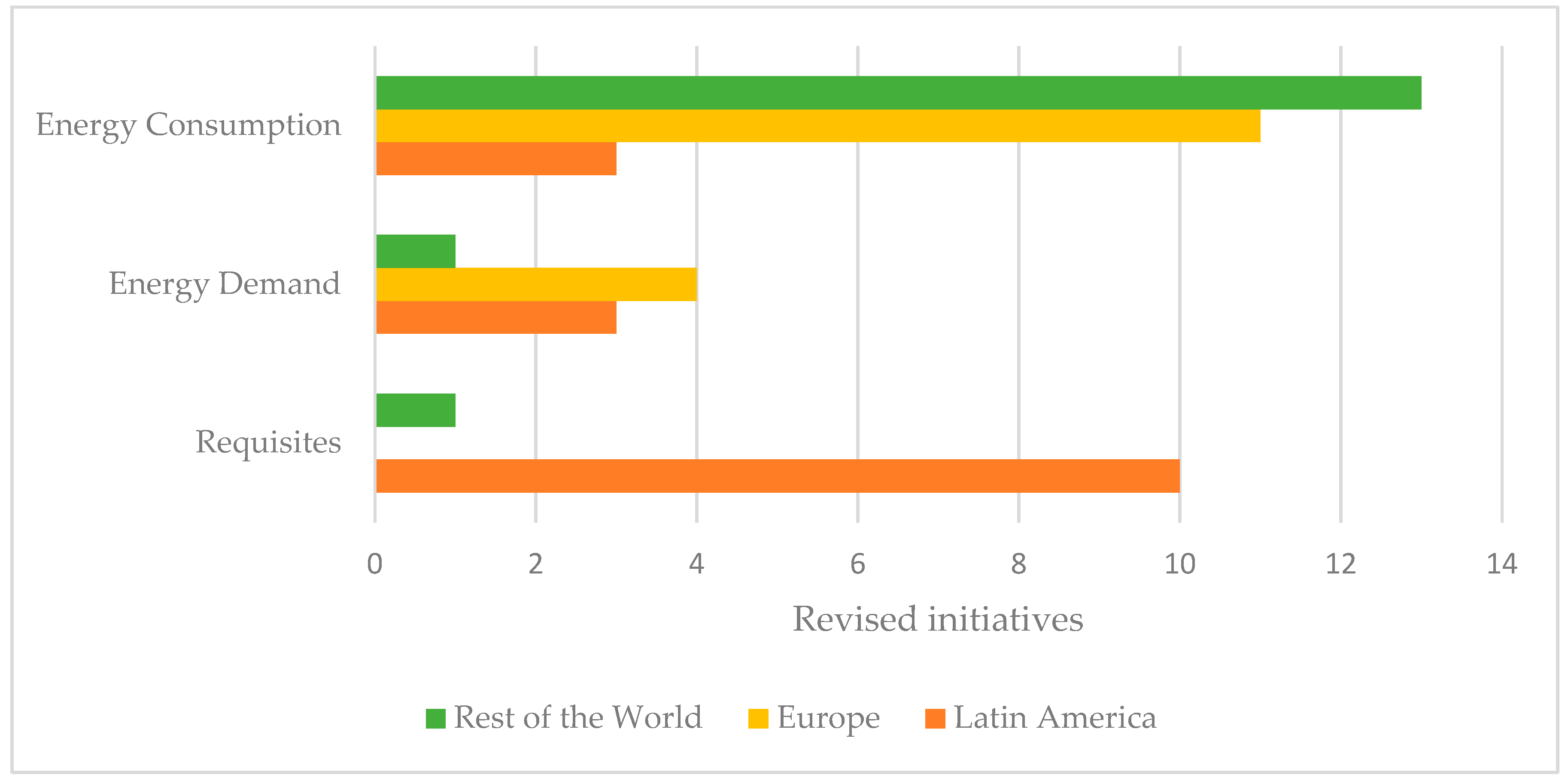
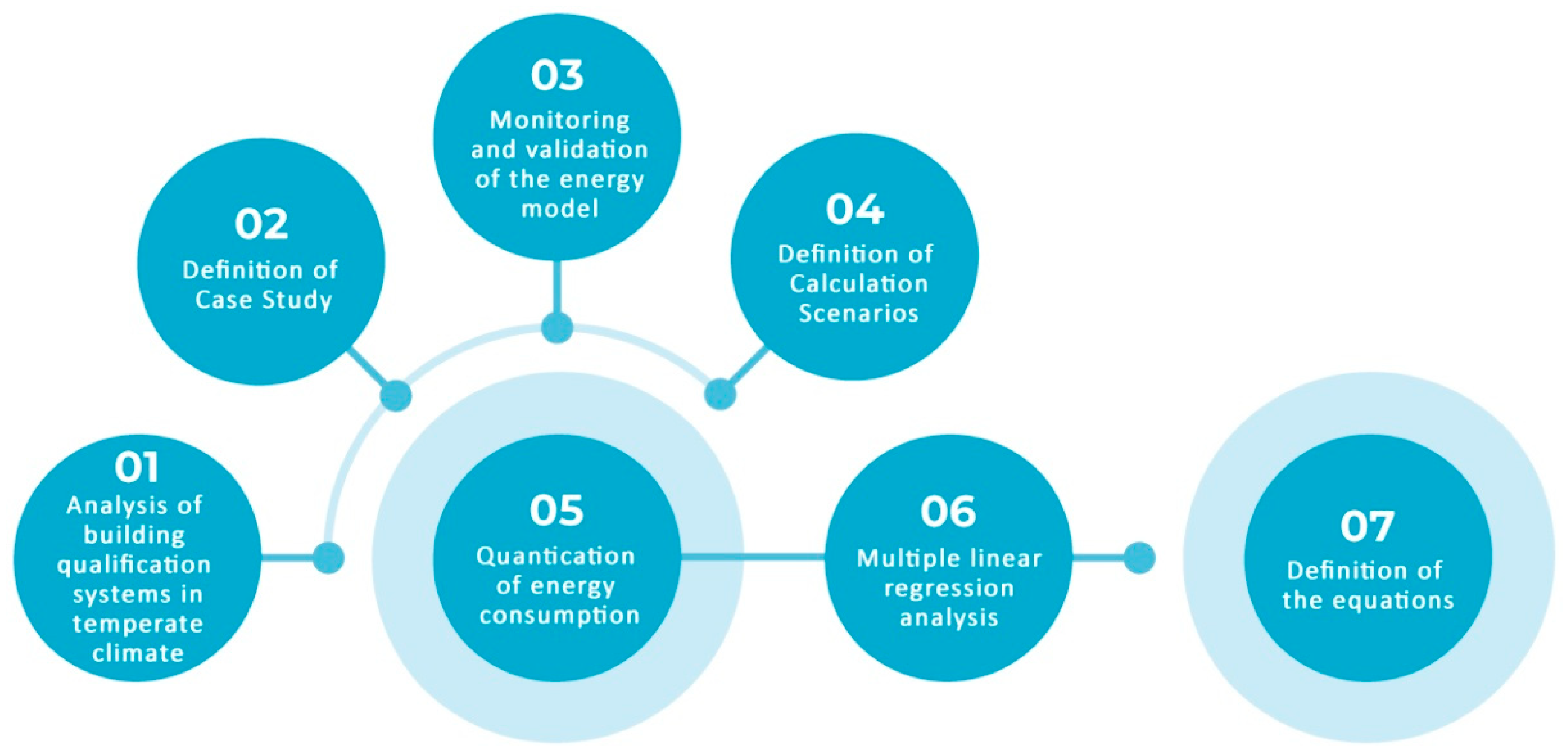
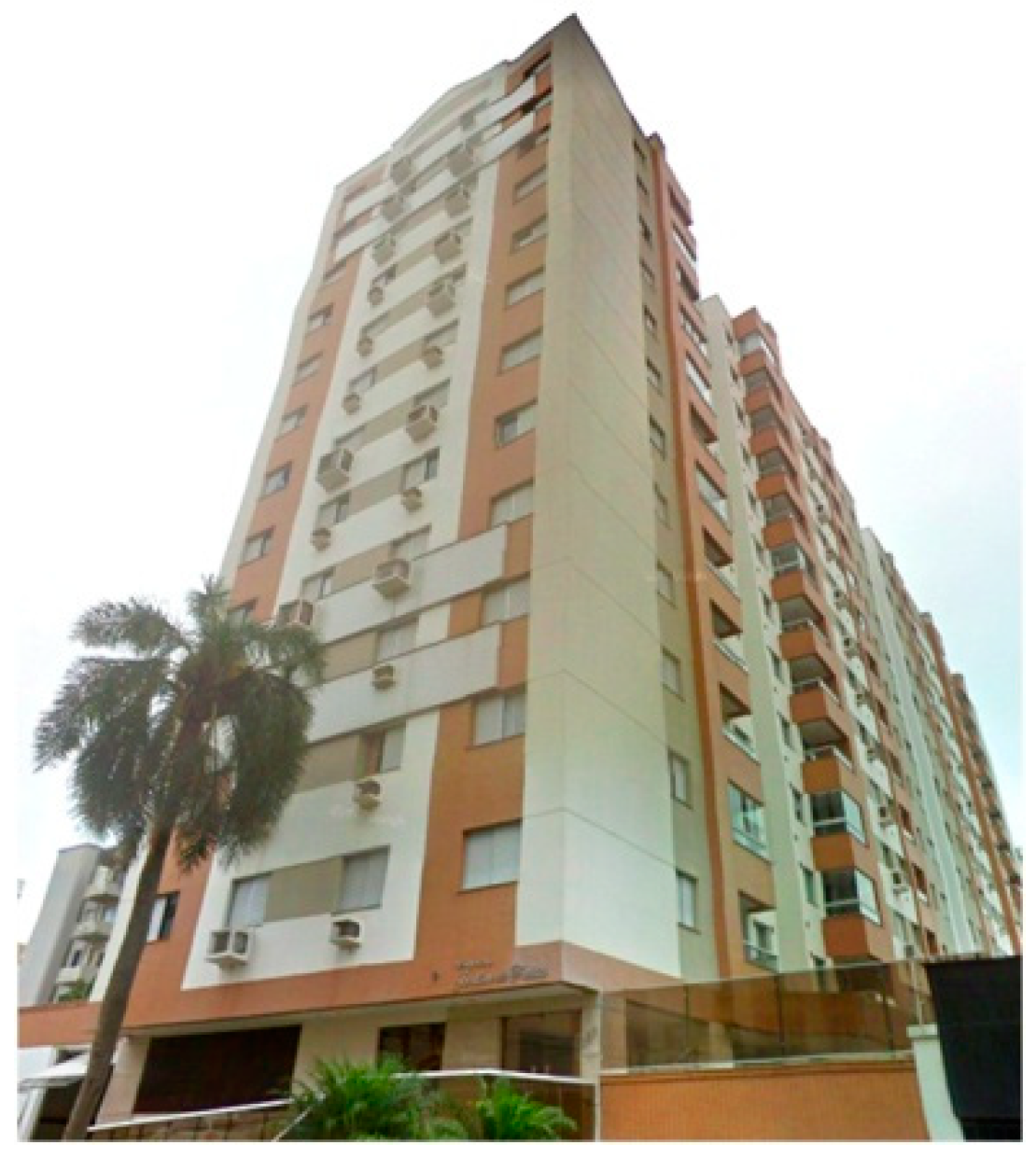

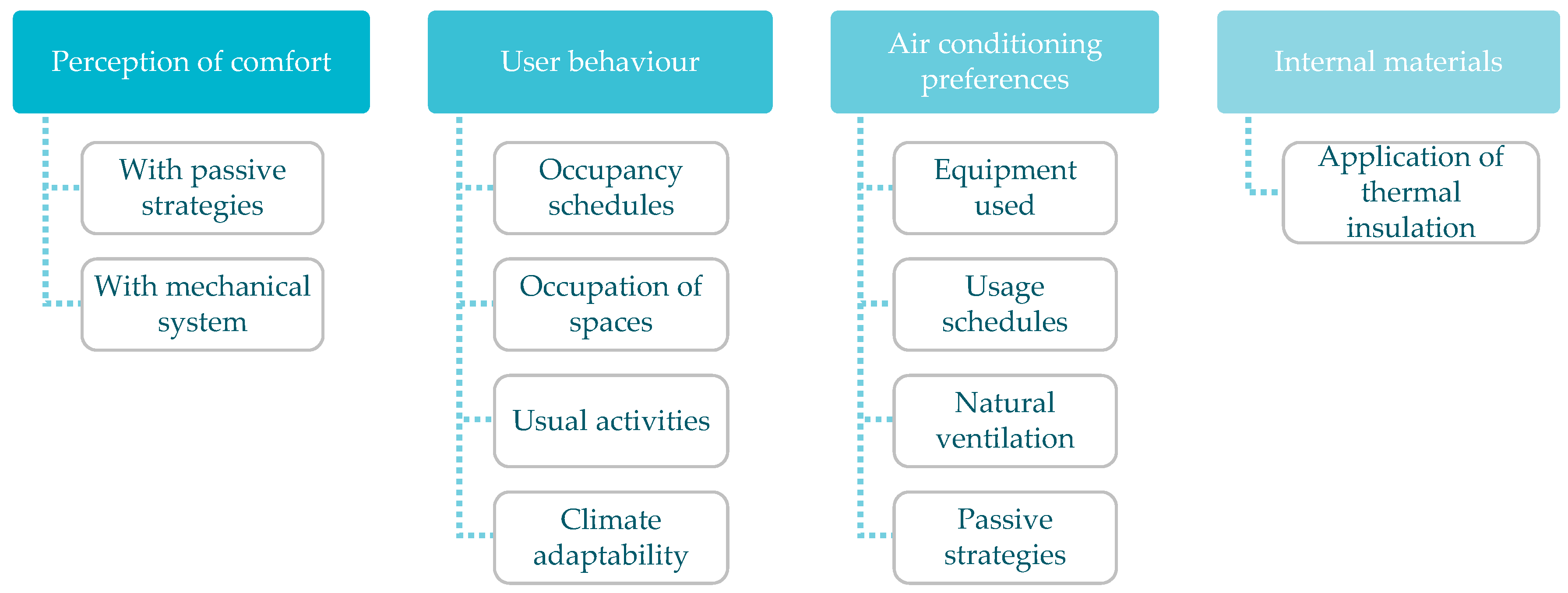
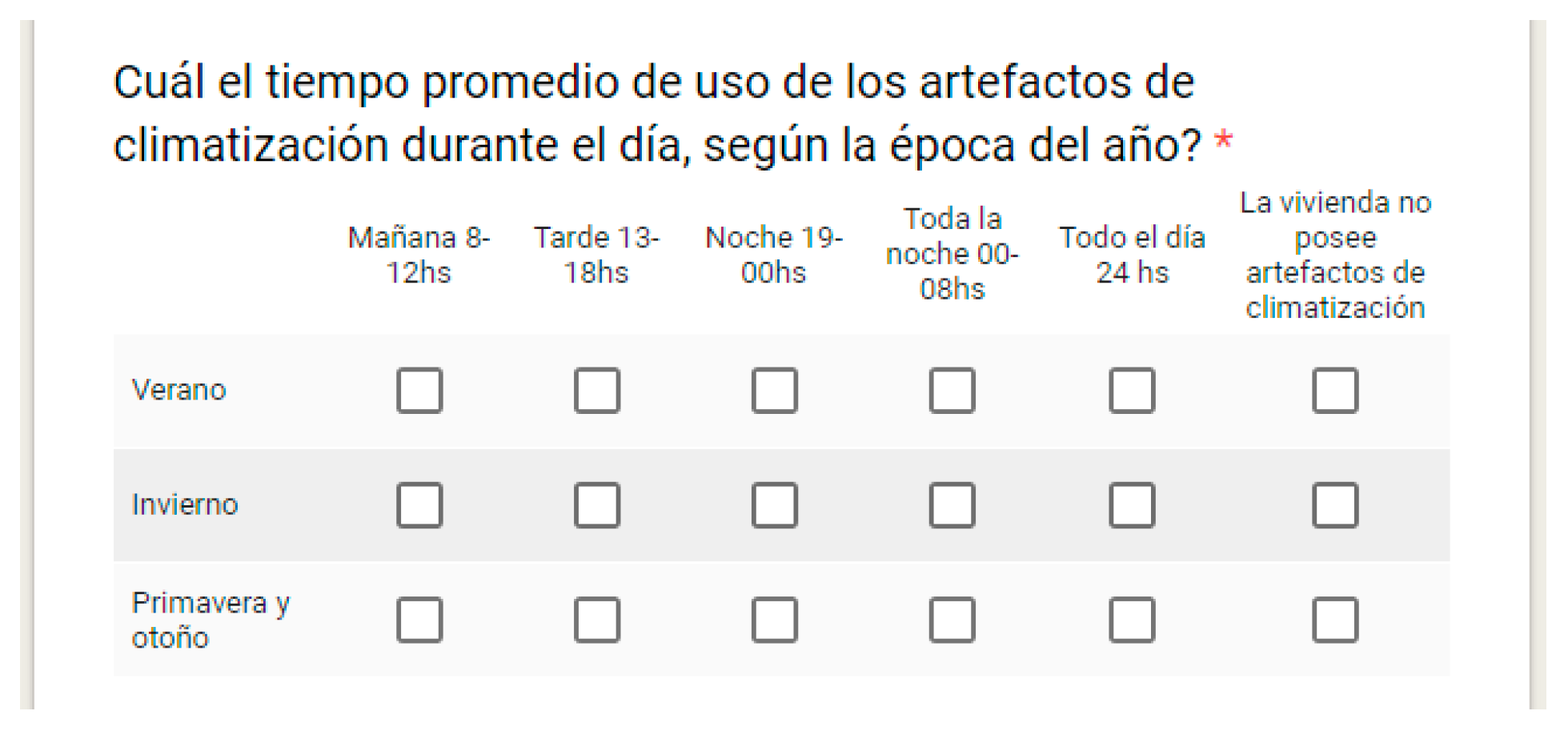



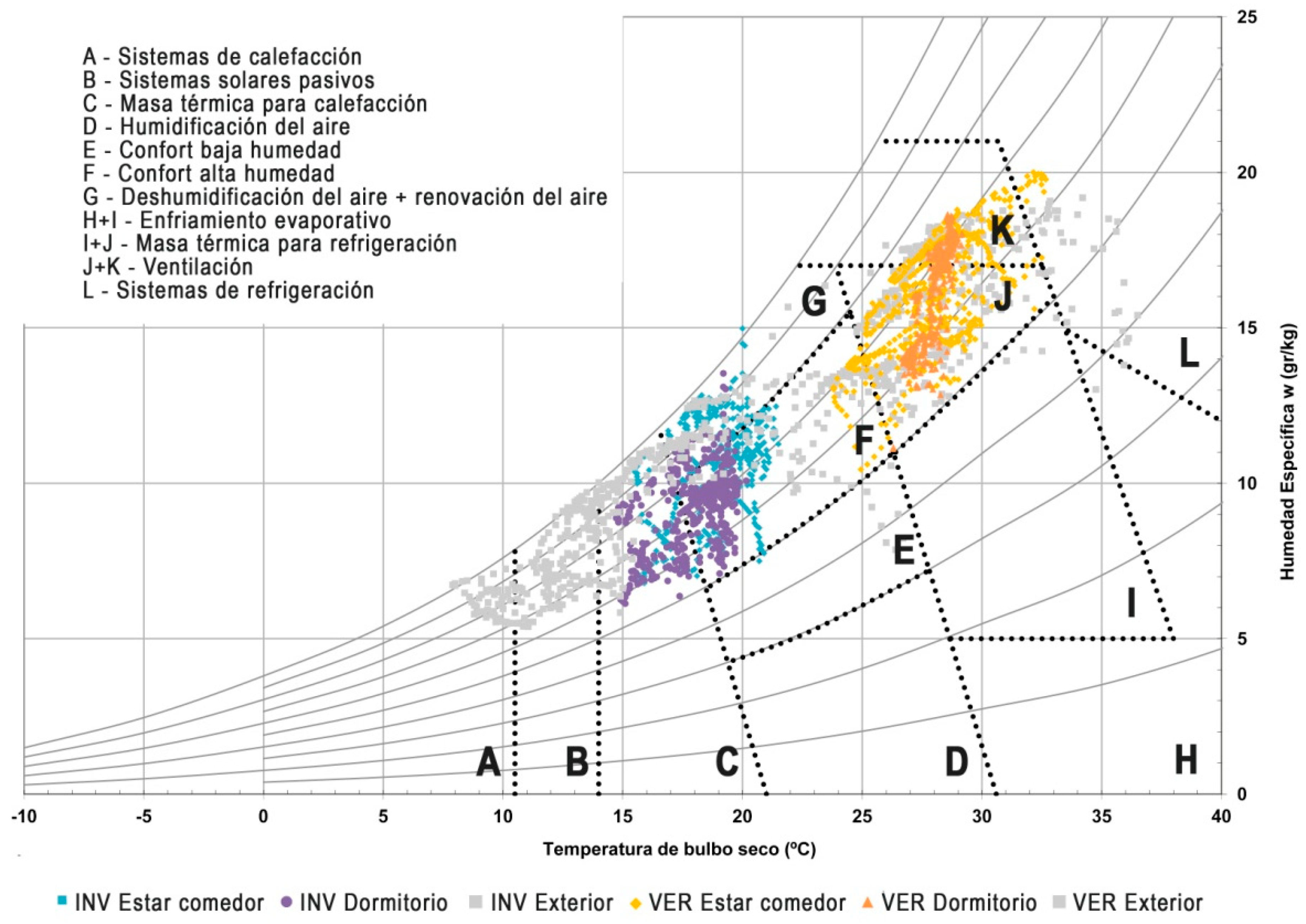
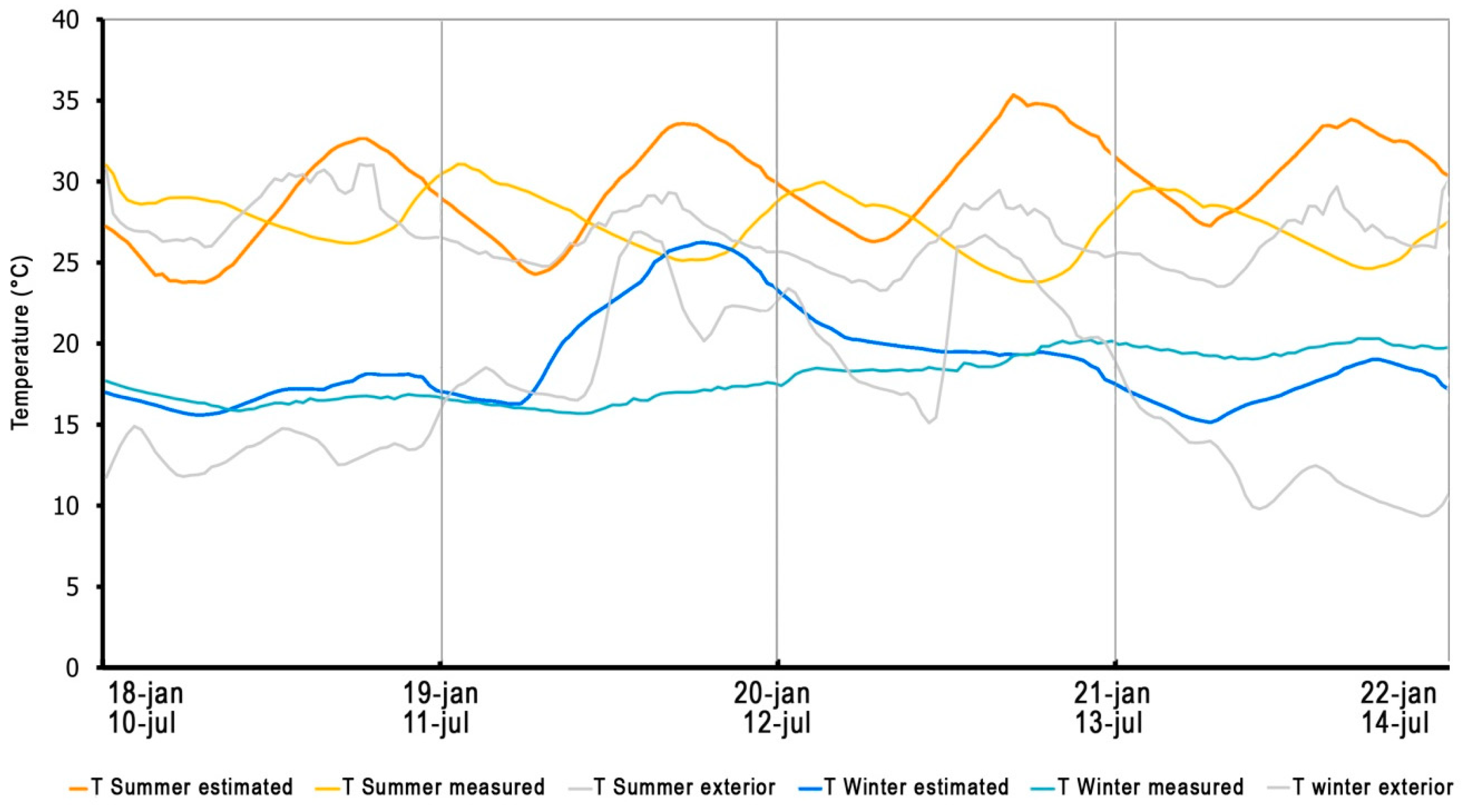
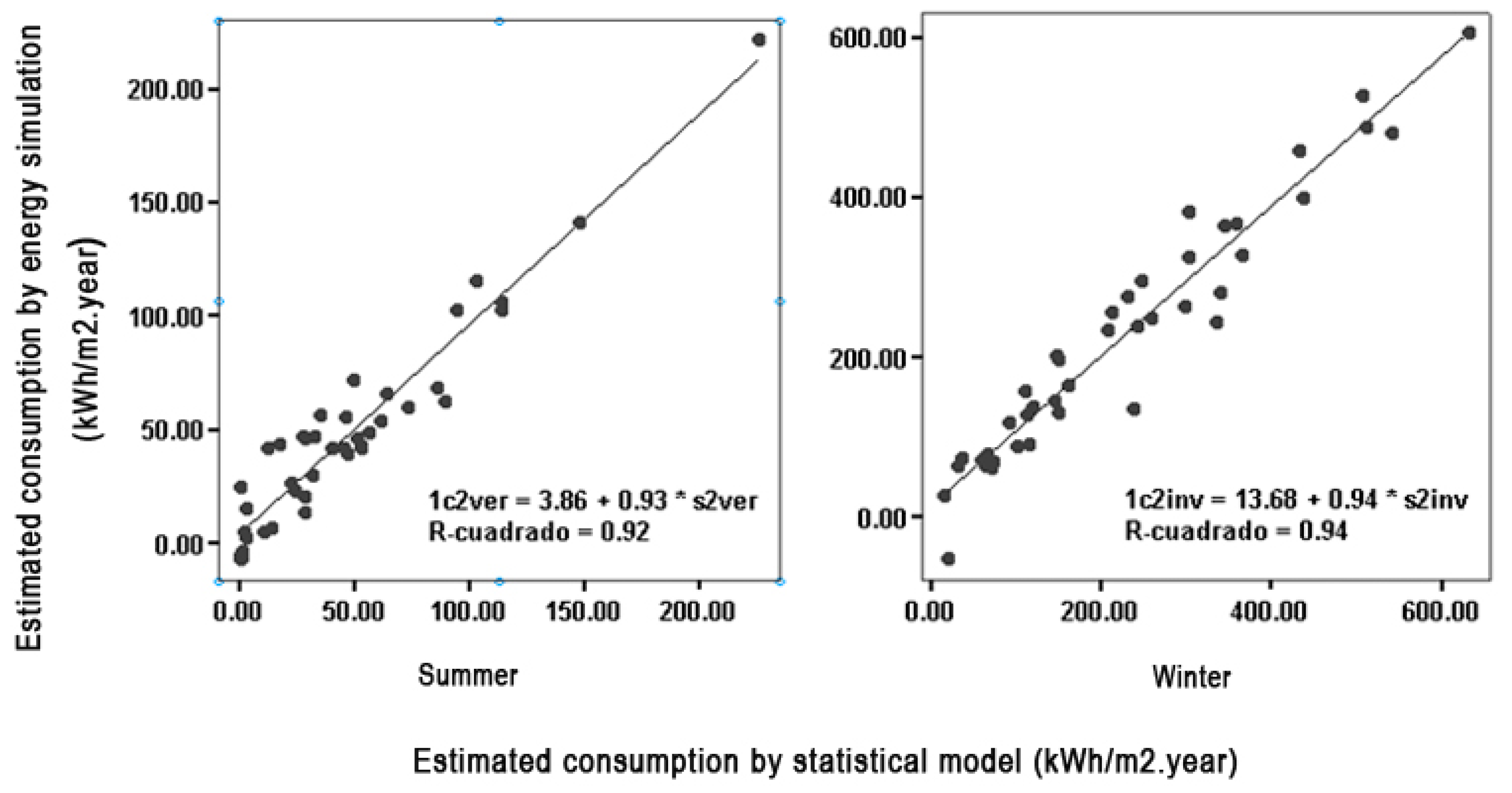
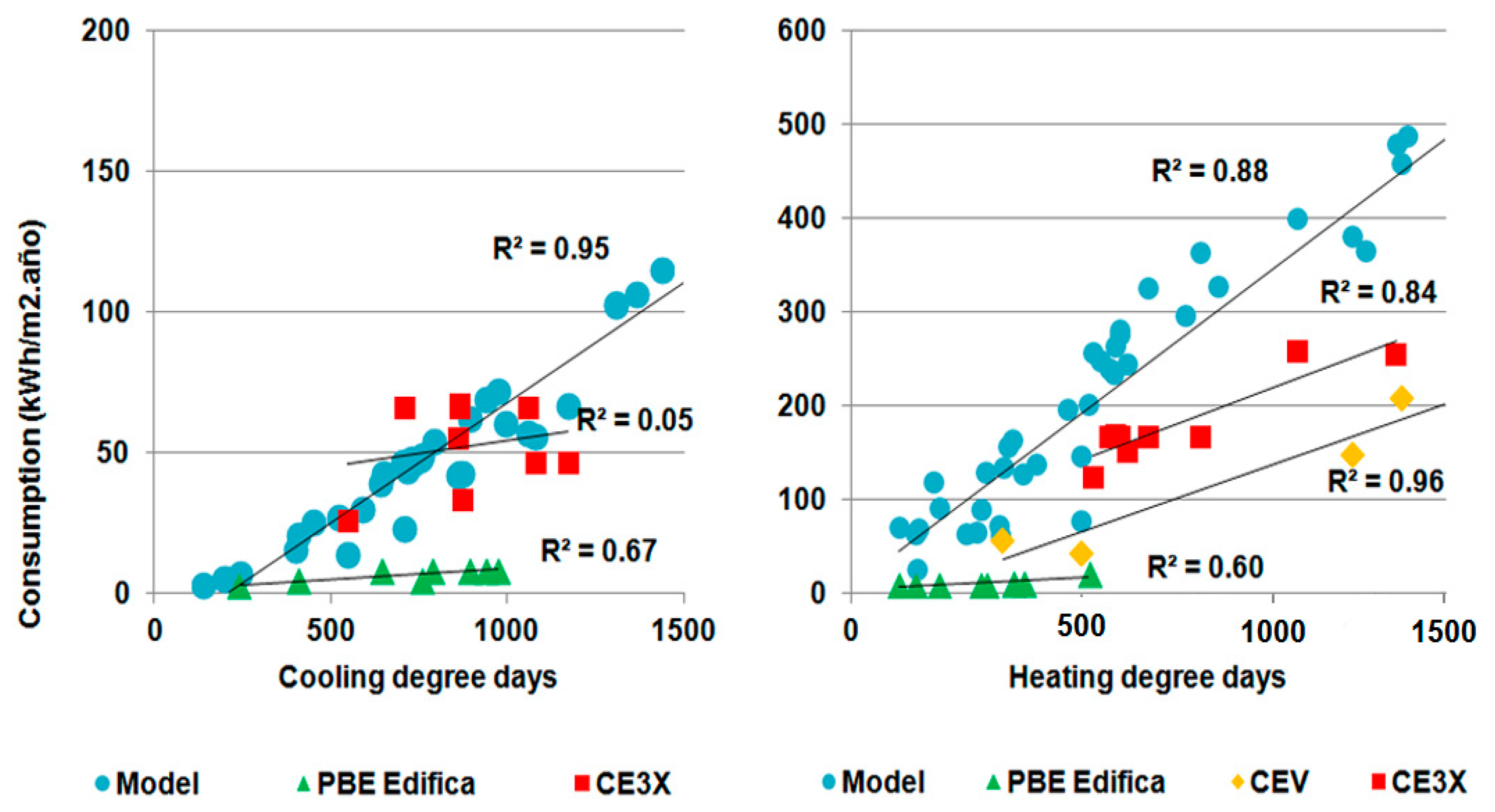
| Country | Building Qualification System | Evaluation |
|---|---|---|
| Africa | ||
| Morocco | Thermal Regulation of Construction in Morocco—RTCM | C |
| South Africa | Energy efficiency in buildings—SANS 204 | C |
| Asia | ||
| China | Evaluation standard for green building | C |
| China | Code for acceptance of energy efficient building construction | C |
| India | Energy conservation building code—ECBC | C |
| India | Green rating integrated habitat assessment—GRIHA | C |
| Japan | Design and Construction Guidelines on the Rationalization of Energy Use for Houses—Dcgreuh | R |
| Japan | Comprehensive Assessment System for Built Environment Efficiency—CASBEE | D, C |
| Central America | ||
| Costa Rica | Requirements for Sustainable Buildings in the Tropics—RESET | R |
| Europe | ||
| Germany | Passive house—Passivhaus | C |
| Germany | Energy Conservation Ordinance—EnEV | C |
| Spain | Technical building code—CTE | D |
| Spain | Energy certification of Spain | C |
| France | Energy performance diagnostic—DPE | C |
| France | Thermic regulation 2012—RT 2012 | C |
| Italy | Decree 26 06 2015-Application of building energy performance calculation methodology and definition of minimum specifications and requirements for buildings (15A05198). | C |
| Portugal | Regulations on Thermal Behaviour of Buildings—RCCTE | D |
| Portugal | System for Energy and Indoor Air Quality Certification of Buildings | C |
| United Kingdom | Building Research Establishment Environmental Assessment Method—BREEAM | C |
| United Kingdom | Energy Performance Certificate—EPC | C |
| Swiss | Standard of thermal energy in building construction—SIA380/1 | D |
| Swiss | Sustainable building standard—MINERGIE | C |
| Turkey | Thermal insulation requirements for buildings-TS 825 | C |
| Turkey | Energy Performance Certificates | C |
| North America | ||
| Canada | Building Environmental Performance Assessment Criteria—BEPAC | C |
| Canada | Green Building Challenge—GBC | C |
| United States | Leadership in Energy & Environmental Design—LEED | C |
| United States | Building energy quotient—bEQ | C |
| Mexico | Sustainable Buildings Certification Program—PCES | C |
| Mexico | Mexican norm of sustainable building-NMX-AA-164-SCFI | D |
| South America | ||
| Argentina | Law 13059/03-Thermal Conditioning Conditions | R |
| Argentina | Energy performance in residential units—IRAM 11900 | R |
| Argentina | Hygrothermal aspects and energy demand of buildings-Ordinance 8757/11 | R |
| Brazil | Brazilian Building Labeling Program—PBE Edifica | C |
| Brazil | High environmental quality—AQUA BRAZIL | D |
| Brazil | Seal Blue House-SELO AZUL | R |
| Chile | Home Energy Rating—CEV | C |
| Chile | Sustainable Building Certification—CES | D |
| Colombia | Sustainable Construction Technical Regulation | R |
| Ecuador | Ecuadorian Construction Standard | R |
| Paraguay | Parameters of thermal comfort—NP 4901715 | R |
| Peru | Thermal and Light Comfort with Energy Efficiency-EM.110 | R |
| Uruguay | Reduction of energy demand for thermal conditioning-Resolution N° 2928/09 | R |
| Oceania | ||
| Australia | Building Codes of Australia | C |
| Australia | Nationwide house energy rating scheme—NatHERS | C |
| New Zealand | New Zealand Building Code—NZBC | C |
| Year | Authors | Country | Typology | Input Data |
|---|---|---|---|---|
| 1991 | Bartels & Fiebig | Australia | R | HC |
| 1994 | LaFrance & Perron | Canada | R | W + EE + P |
| 1995 | Kreider et al. | United States | O | W + HC |
| 1995 | Hsiao et al. | - | R | O + HC |
| 1996 | Jaccard & Baille | Canada | R | HC |
| 1998 | Farahbakhsh et al. | Canada | R | B + O |
| 1999 | Fung et al. | Canada | R | B + W + EE + P + PE |
| 2000 | Kalogirou & Bojic | - | R | W + BE |
| 2002 | Shipley et al. | Canada | O | B + HC |
| 2002 | Lins et al. | Brazil | R | HC |
| 2002 | Mihalakakou et al. | Greece | R | W |
| 2004 | Shimoda et al. | Japan | R | O |
| 2005 | Parekh | - | A | B + O |
| 2006 | Petersdorff et al. | European Union | R | W + BE + T |
| 2007 | Kadian et al. | India | R | HC |
| 2007 | Raffio et al. | - | R | W + HC |
| 2008 | Swan et al. | Canada | R | B |
| 2009 | Hu | China | O | W + B |
| 2010 | Fumo | United States | R | HC |
| 2010 | Lam | China | C | B + O + EE |
| 2010 | Li | China | R | B |
| 2010 | Min et al. | United States | R | O + HC |
| 2010 | Wong et al. | - | O | W + BE + O |
| 2011 | Escriva-Escriva et al. | Spain | O | HC |
| 2012 | Melo | Spain | O | B + T |
| 2012 | Aranda | Brazil | C | B + W + EE |
| 2013 | Filippín | Argentina | R | HC + M |
| 2013 | Korolija | United Kingdom | O | B + T + EE + BE + O |
| 2013 | Zhou S. & Zhu N | China | O | W + BE |
| 2014 | Asadi | United States | C | BE + T |
| 2014 | Braun | United Kingdom | C | HC |
| 2014 | Fan | China | O | W |
| 2014 | Farzana | China | R | W + O |
| 2014 | Jain | United States | R | W |
| 2014 | Johnson | United States | R | O |
| 2014 | Mena | Spain | O | W |
| 2014 | Mastrucci | - | R | B + P |
| 2015 | Shams Amiri | United States | C | BE + T + O |
| 2015 | Salvetti | Argentina | R | B + O |
| 2016 | Pulido-Arcas | Chile | O | BE + EE |
| 2017 | Pino-Mejías | Chile | O | BE |
| 2018 | Nath Lopes & Lamberts | Brazil | O | W + B + BE + EE + O |
| 2018 | Ran Yoon | South Korea | O | O |
| Country | NBER and TES | Parameters of the Thermal Envelope |
|---|---|---|
| Argentina | IRAM 11900:2007 Law 13059:2003 IRAM 11604:2001 IRAM 11605:1996 IRAM 11625:2000 IRAM 11507-4:2010 | U-value: walls, roof, floor, glazing Global losses coefficient Solar Heat Gain Coefficient (SHGC) Air infiltration rate Condensation risk |
| Brazil | PBE Edifica RTQ-R | U-value: walls, roof Thermal capacity: wall and roof Solar absorptivity for opaque enclosures Window to Wall ratio Natural ventilation factor |
| Chile | CEV Thermal Regulation | U-value: walls, roof, floor, glazing Thermal inertia SHGC Air infiltration rate |
| Mexico | Ecocasa NOM-020-ENER-2011 NOM-024-ENER-2012 | U-value: walls, roof, floor, glazing Comfort range |
| Spain | RD 47/2007 RD 235/2013 Technical Building Code: Energy Saving Document (CTE DB-HE) | U-value: walls, roof, floor, glazing, internal partitions SHGC Air infiltration rate Condensation risk |
| Main Bedroom | Bedroom | Living Room | Kitchen | Bathroom | |
|---|---|---|---|---|---|
| People | 2 | 1 | 2 | 1 | 1 |
| Hours | 8 | 8 | 4 | 2 | 2 |
| Activity | Sleep | Sleep | Read/eat | Cook | Shower |
| Metabolism (W/pers) | 72 | 72 | 110 | 230 | 180 |
| Clothing (clo) | Summer = 0.3 | Winter = 1,0 | Spring-Autumn = 0.5 | ||||
| Thermal zone | Conditioned | Ventilated | |||
| Tª setpoint | Minimum = 18 °C | Maximum = 27 °C | - | |||
| Air change rate | 2 | ||||
| Country | Location | CDD | HDD | Climatic Zone | U Façade | U Roof |
|---|---|---|---|---|---|---|
| Argentina | La Rioja | 1368 | 621 | Ia | 0.93 | 0.45 |
| Santiago del Estero | 1311 | 450 | ||||
| Corrientes | 1308 | 192 | Ib | 1.00 | 0.45 | |
| Catamarca | 1440 | 531 | IIa | 0.90 | 0.45 | |
| Paraná | 738 | 750 | IIb | 0.99 | 0.45 | |
| Buenos Aires | 732 | 771 | IIIa | 1.00 | 0.48 | |
| Córdoba | 705 | 714 | ||||
| Rosario | 642 | 957 | ||||
| La Plata | 525 | 1050 | IIIb | 0.95 | 0.48 | |
| Mar del Plata | 141 | 1293 | IVc | 0.85 | 0.48 | |
| Brazil | Curitiba | 243 | 681 | 1 | 2.5 | 2.3 |
| Ponta Grossa | 408 | 492 | 2 | 2.5 | 2.3 | |
| Santa María | 759 | 462 | ||||
| Blumenau | 975 | 138 | 3 | 3.7 | 2.3 | |
| Chapecó | 648 | 387 | ||||
| Criciúma | 792 | 252 | ||||
| Florianópolis | 942 | 183 | ||||
| Porto Alegre | 894 | 372 | ||||
| Chile | Antofagasta | 198 | 657 | 1 | 4 | 0.84 |
| Copiacó | 453 | 435 | 2 | 3 | 0.60 | |
| Valparaíso | 0 | 1434 | ||||
| Santiago | 201 | 1375 | 3 | 1.9 | 0.47 | |
| Concepción | 0 | 1490 | 4 | 1.7 | 0.38 | |
| Temuco | 0 | 1334 | 5 | 1.6 | 0.33 | |
| Mexico | Aguascalientes | 589 | 423 | − | 0.83 | 0.83 |
| Ciudad de Mexico | 195 | 330 | − | 0.9 | 0.9 | |
| Guadalajara | 717 | 360 | − | 0.71 | 0.71 | |
| Hermosillo | 1404 | 516 | − | 0.47 | 0.47 | |
| Juárez | 996 | 1473 | − | 0.62 | 0.62 | |
| León | 756 | 189 | − | 0.71 | 0.71 | |
| Monterrey | 1388 | 237 | − | 0.55 | 0.55 | |
| Puebla | 156 | 429 | − | 0.83 | 0.83 | |
| Tijuana | 402 | 657 | − | 0.71 | 0.71 | |
| Spain | Málaga | 864 | 693 | A3 | 0.94 | 0.5 |
| Murcia | 1060 | 849 | B3 | 0.82 | 0.45 | |
| Palma | 873 | 792 | ||||
| Valencia | 864 | 756 | ||||
| Alicante | 861 | 771 | B4 | 0.82 | 0.45 | |
| Córdoba | 1080 | 999 | ||||
| Seville | 1173 | 741 | ||||
| Barcelona | 549 | 1276 | C2 | 0.73 | 0.41 | |
| Granada | 708 | 1360 | C3 | 0.73 | 0.41 |
| Element | Composition | U W/m2K |
|---|---|---|
| Wall I | Hollow ceramic brick—15 cm | 2.510 |
| Wall II | Double ceramic brick wall—10 cm | 1.823 |
| Wall III | Double ceramic brick wall with 1.5 cm of expanded polystyrene 20 kg/m3 | 1.101 |
| Wall IV | Hollow ceramic brick-15 cm with fiberglass—3.5 cm | 0.821 |
| Wall V | Hollow ceramic brick with 5 cm of expanded polystyrene of 30 kg/m3 | 0.503 |
| Roof I | Concrete slab-15cm with alu-zinc roof tiles | 1.960 |
| Roof II | Concrete slab-15 cm with fiberglass—3.5 cm | 0.854 |
| Roof III | Concrete slab-15 cm with fiberglass—5 cm | 0.680 |
| Roof IV | Concrete slab-15 cm with expanded polystyrene of 30 kg/m3—5 cm | 0.526 |
| Roof V | Concrete slab-15 cm with fiberglass—10 cm | 0.405 |
| Country | Location | Cooling_R | Heating_R | Cooling_N | Heating_N | Ave Cool | Ave Heat |
|---|---|---|---|---|---|---|---|
| Argentina | La Rioja | 152.5 | 150.3 | 113.6 | 114.5 | 81.21 60.87 71.04 | 238.77 172.57 205.67 |
| Santiago del Estero | 126.8 | 111.2 | 94.7 | 82.9 | |||
| Corrientes | 148.6 | 74 | 113.5 | 48.6 | |||
| Catamarca | 132.9 | 120.7 | 102.5 | 86.3 | |||
| Paraná | 70.3 | 209 | 51.3 | 150.6 | |||
| Buenos Aires | 43.6 | 339.9 | 32.9 | 242.5 | |||
| Córdoba | 37.8 | 258.3 | 27.9 | 183.6 | |||
| Rosario | 64.6 | 248.4 | 47.2 | 181.3 | |||
| La Plata | 30.9 | 364.8 | 22.6 | 263.6 | |||
| Mar del Plata | 4.1 | 511.1 | 2.5 | 371.8 | |||
| Brazil | Curitiba | 17.3 | 148.4 | 14.3 | 139.1 | 54.64 49.64 52.14 | 110.14 101.40 105.77 |
| Ponta Grossa | 32.5 | 112.5 | 28.1 | 103.3 | |||
| Santa María | 62.2 | 162.7 | 56.6 | 149.7 | |||
| Blumenau | 53.9 | 59.2 | 49.5 | 53.4 | |||
| Chapecó | 14 | 149.3 | 11.8 | 136.7 | |||
| Criciúma | 67.6 | 115 | 61.7 | 104.9 | |||
| Florianópolis | 92.9 | 33 | 85.6 | 30.4 | |||
| Porto Alegre | 96.7 | 101 | 89.5 | 93.7 | |||
| Chile | Antofagasta | 2.6 | 65.6 | 1.7 | 63.4 | 3.28 2.22 2.75 | 363.15 277.76 306.14 |
| Concepción | 0 | 507.5 | 0 | 392.4 | |||
| Copiacó | 1.2 | 238.9 | 0.6 | 200.3 | |||
| Santiago | 14.8 | 432.6 | 10.7 | 372.4 | |||
| Temuco | 0.9 | 632.4 | 0.3 | 506.8 | |||
| Valparaíso | 0.2 | 301.9 | 0 | 259.3 | |||
| Mexico | Aguascalientes | 42.2 | 36.6 | 31.5 | 25 | 79.93 58.68 69.31 | 96.87 67.60 82.23 |
| Ciudad de Mexico | 1.8 | 68 | 1 | 44.1 | |||
| Guadalajara | 26.9 | 63.3 | 17.3 | 48.6 | |||
| Hermosillo | 306.7 | 19.6 | 225.7 | 12.4 | |||
| Juárez | 101.7 | 359.3 | 72.8 | 248.3 | |||
| León | 36.5 | 14.7 | 27.7 | 7.9 | |||
| Monterrey | 194.3 | 92.2 | 147.5 | 56.7 | |||
| Puebla | 2.9 | 71.7 | 1.4 | 50.2 | |||
| Tijuana | 6.4 | 146.4 | 3.2 | 115.2 | |||
| Spain | Málaga | 49.9 | 213.3 | 40.1 | 139.6 | 56.99 43.24 50.12 | 327.48 220.60 274.04 |
| Murcia | 42.9 | 303.9 | 35.1 | 204.4 | |||
| Palma | 71.8 | 334.8 | 52.8 | 245.1 | |||
| Valencia | 72 | 297.2 | 53.1 | 206.8 | |||
| Alicante | 56.2 | 231 | 45.6 | 153.3 | |||
| Córdoba | 60.3 | 344.4 | 46.3 | 233.1 | |||
| Seville | 89.4 | 243.7 | 63.7 | 174.1 | |||
| Barcelona | 40.4 | 437.1 | 28.5 | 287 | |||
| Granada | 30 | 541.9 | 24 | 342 |
| N ° | Variable | Definition |
|---|---|---|
| 1 | Cooling | Cooling energy consumption (kWh/m2) |
| 2 | Heating | Heating energy consumption (kWh/m2) |
| 3 | A | Altitude (°) |
| 4 | L | Latitude (°) |
| 5 | Tavg | Average temperature—monthly (°C) |
| 6 | RH | Relative humidity (%) |
| 7 | RAD | Global radiation (W/m2) |
| 8 | Wsp | Wind speed (km/h) |
| 9 | SKcv | Covered sky (%) |
| 10 | CDD | Cooling degree—days |
| 11 | HDD | Heating degree—days |
| 12 | TDmax | Maximum design temperature (°C) |
| 13 | TDmin | Minimum design temperature (°C) |
| 14 | Tmax-avg | Average maximum temperature–hottest month (°C) |
| 15 | Tmin-avg | Average minimum temperature–coldest month (°C) |
| 16 | RHas | Average relative humidity for the three hottest months% |
| 17 | RHaw | Average relative humidity for the three coldest months% |
| 18 | RADas | Average global radiation for the three hottest months (W/m2) |
| 19 | RADaw | Average global radiation for the three coldest months (W/m2) |
| 20 | Wspas | Average wind speed for the three hottest months (km/h) |
| 21 | Wspaw | Average wind speed for the three coldest months |
| 22 | SKcvas | Average of covered sky for the three hottest months (%) |
| 23 | SKcvaw | Average of covered sky for the three coldest months (%) |
| 24 | CDDs | Average cooling degree-days for the three hottest months |
| 25 | HDDw | Average heating degree-days for the three coldest months |
| 26 | TDmax-s | Maximum design temperature for the three hottest months (°C) |
| 27 | TDmin-w | Minimum design temperature for the three coldest months (°C) |
| Condition | Model | Variables | R | R2 | R2 Corrected | Typical Error |
|---|---|---|---|---|---|---|
| Summer | 1 | CDD | 0.936 | 0.877 | 0.874 | 16.39443 |
| 2 | CDD. L | 0.951 | 0.904 | 0.899 | 14.67044 | |
| 3 | CDD. L. CDDs | 0.959 | 0.920 | 0.913 | 13.58502 | |
| Winter | 1 | HDD | 0.929 | 0.863 | 0.860 | 59.35259 |
| 2 | HDD. RADaw | 0.946 | 0.895 | 0.889 | 52.78454 | |
| 3 | HDD. RADaw. Tmin-avg | 0.962 | 0.925 | 0.920 | 44.95103 | |
| 4 | HDD. RADaw. Tmin-avg. Wspaw | 0.968 | 0.938 | 0.931 | 41.58207 |
| Condition | Model | Variables | B | Typical Error | Beta | t | Sig |
|---|---|---|---|---|---|---|---|
| Summer | 1 | (Constant) | −17.832 | 4.553 | − | −3.917 | 0.000 |
| CDD | 0.085 | 0.005 | 0.936 | 16.890 | 0.000 | ||
| 2 | (Constant) | −22.240 | 4.286 | − | −5.189 | 0.000 | |
| CDD | 0.089 | 0.005 | 0.987 | 19.013 | 0.000 | ||
| L | −0.253 | 0.076 | −0.172 | −3.310 | 0.002 | ||
| 3 | (Constant) | −13.616 | 5.069 | − | −2.686 | 0.011 | |
| CDD | 0.123 | 0.013 | 1.353 | 9.513 | 0.000 | ||
| L | −0.221 | 0.072 | −0.150 | −3.078 | 0.004 | ||
| CDDs | −0.207 | 0.076 | −0.394 | −2.735 | 0.009 | ||
| Winter | 1 | (Constant) | 8.300 | 16.202 | − | 0.512 | 0.611 |
| HDD | 0.282 | 0.018 | 0.929 | 15.887 | 0.000 | ||
| 2 | (Constant) | 192.751 | 56.100 | − | 3.436 | 0.001 | |
| HDD | 0.242 | 0.020 | 0.799 | 12.359 | 0.000 | ||
| RADaw | −537.190 | 157.903 | −0.220 | −3.402 | 0.002 | ||
| 3 | (Constant) | 464.670 | 83.480 | − | 5.566 | 0.000 | |
| HDD | 0.162 | 0.026 | 0.533 | 6.163 | 0.000 | ||
| RADaw | −933.288 | 167.410 | −0.382 | −5.575 | 0.000 | ||
| Tmin-avg | −14.385 | 3.622 | −0.277 | −3.972 | 0.000 | ||
| 4 | (Constant) | 394.912 | 81.366 | − | 4.854 | 0.000 | |
| HDD | 0.164 | 0.024 | 0.541 | 6.759 | 0.000 | ||
| RADaw | −871.390 | 156.525 | −0.357 | −5.567 | 0.000 | ||
| Tmin-avg | −12.793 | 3.401 | −0.246 | −3.762 | 0.001 | ||
| Wspaw | 3.233 | 1.188 | 0.116 | 2.722 | 0.010 |
| Country | System | Condition | Main Climatic Variable | Secondary Climatic Variable |
|---|---|---|---|---|
| ARG | IRAM 11659 | Summer | Max design temperature | Solar radiation |
| IRAM 11604 | Winter | degree days | − | |
| BRA | PBE Edifica | Summer | degree hour | − |
| Winter | degree hour | − | ||
| CHI | − | Summer | − | − |
| CEV | Winter | degree days | Altitude | |
| MEX | NOM-020 | Summer | Ave max temperature | Solar radiation |
| SPA | CEE | Summer | degree days | Solar radiation |
| Winter | degree days | Solar radiation |
| Country | Location | Heating Consumption | Cooling Consumption | ||||
|---|---|---|---|---|---|---|---|
| Equation | Nat. Tool | Δ (%) | Equation | Nat. Tool | Δ (%) | ||
| Argentina | Blumenau | 12.0 | 9.1 | 31.9 | 68.6 | 8.3 | 726.4 |
| Chapecó | 43.6 | 9.1 | 379.4 | 37.9 | 8.3 | 357.1 | |
| Criciúma | 22.7 | 9.1 | 149.1 | 63.2 | 8.3 | 661.7 | |
| Curitiba | 77.1 | 21.5 | 258.8 | 2.2 | 2.6 | −17.0 | |
| Florianópolis | 6.3 | 9.1 | −30.0 | 62.4 | 8.3 | 651.0 | |
| Ponta Grossa | 38.5 | 10.5 | 266.9 | 24.4 | 4.3 | 467.4 | |
| Porto Alegre | 18.39 | 9.1 | 102.0 | 59.08 | 8.3 | 611.8 | |
| Santa Maria | 59.53 | 10.5 | 466.9 | 59.26 | 4.3 | 1278.2 | |
| Chile | Antofagasta | 15 | 43.0 | −34.8 | − | − | − |
| Concepción | 227.8 | 232.0 | 1.8 | − | − | − | |
| Copiapó | 49.3 | 56.0 | 12.0 | − | − | − | |
| Santiago | 203.5 | 209.0 | 2.6 | − | − | − | |
| Temuco | 262.8 | 289.0 | 9.0 | − | − | − | |
| Valparaíso | 155.6 | 147.5 | 5.9 | − | − | − | |
| Spain | Alicante | 124.3 | 167.5 | −25.8 | 47.1 | 55.1 | −14.5 |
| Barcelona | 178.3 | 258.75 | −31.1 | 36.5 | 26.0 | 40.4 | |
| Córdoba | 172.0 | 167.5 | 2.7 | 71.5 | 46.2 | 54.8 | |
| Granada | 211.5 | 255 | −17.1 | 43.9 | 66 | −33.5 | |
| Málaga | 114.8 | 123.75 | −7.2 | 52.3 | 66 | −20.8 | |
| Murcia | 152.9 | 167.5 | −8.7 | 51.1 | 66 | −22.6 | |
| Palma | 98.3 | 152 | −35.3 | 57.8 | 33.1 | 75.2 | |
| Seville | 99.4 | 167.5 | −40.7 | 102.6 | 46.2 | 122.1 | |
| Valencia | 113.6 | 168.75 | −32.7 | 61 | 66 | −7.2 | |
© 2019 by the authors. Licensee MDPI, Basel, Switzerland. This article is an open access article distributed under the terms and conditions of the Creative Commons Attribution (CC BY) license (http://creativecommons.org/licenses/by/4.0/).
Share and Cite
Reus-Netto, G.; Mercader-Moyano, P.; Czajkowski, J.D. Methodological Approach for the Development of a Simplified Residential Building Energy Estimation in Temperate Climate. Sustainability 2019, 11, 4040. https://doi.org/10.3390/su11154040
Reus-Netto G, Mercader-Moyano P, Czajkowski JD. Methodological Approach for the Development of a Simplified Residential Building Energy Estimation in Temperate Climate. Sustainability. 2019; 11(15):4040. https://doi.org/10.3390/su11154040
Chicago/Turabian StyleReus-Netto, Gabriela, Pilar Mercader-Moyano, and Jorge D. Czajkowski. 2019. "Methodological Approach for the Development of a Simplified Residential Building Energy Estimation in Temperate Climate" Sustainability 11, no. 15: 4040. https://doi.org/10.3390/su11154040
APA StyleReus-Netto, G., Mercader-Moyano, P., & Czajkowski, J. D. (2019). Methodological Approach for the Development of a Simplified Residential Building Energy Estimation in Temperate Climate. Sustainability, 11(15), 4040. https://doi.org/10.3390/su11154040





